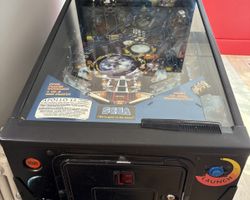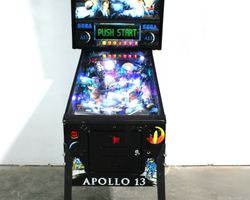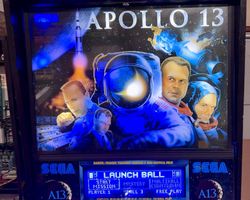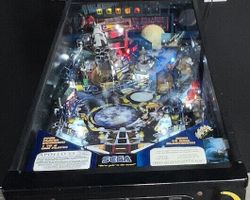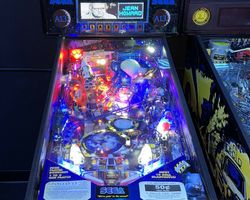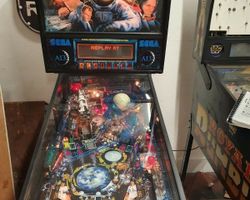Apollo 13
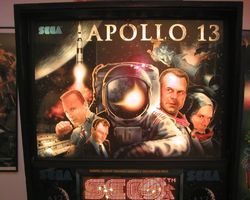
Average Prices: USD $1,000 to $2,800
Produced: October, 1995
Machine Type: Solid State Electronic
MPU: Sega/Stern Whitestar
Players: 6
Design by: Joe Kaminkow, Joe Balcer
Art by: Mark Raneses, Jeff Busch
Dots/Animation by: Kurt Andersen, Jack Liddon
Mechanics by: John Borg, Joe Balcer, Rob Hurtado
Music by: Brian Schmidt
Sound by: Brian Schmidt
Software by: Orin Day, Lonnie D. Ropp
The pinball machine "Apollo 13" from Sega Pinball, Inc., launched in October 1995, brought the suspense and triumph of space exploration to the arcade. Inspired by the popular film of the same name, this machine encapsulated the perilous journey of the Apollo 13 mission, aiming to immerse players in a high-stakes struggle for survival and return to Earth. With a production run of 1,500 units, it marked a significant entry for Sega Pinball during the mid-1990s, operating on the robust Sega/Stern Whitestar MPU.
The design team behind "Apollo 13" included Joe Balcer and Joe Kaminkow, who steered the game’s core concept. Balcer also contributed to the mechanical design alongside John Borg and Rob Hurtado. The visual identity was crafted by artists Jeff Busch and Markus Rothkranz, with Jeff Busch specifically responsible for the distinct backglass and playfield artwork. Marc Raneses served as Jeff’s art assistant, handling screen print production for the playfield and cabinet. The auditory experience, a critical component of thematic immersion, was developed by Brian Schmidt, who composed both the music and sound effects. Software integration was managed by Lonnie D. Ropp, Neil Falconer, and Orin Day, while Jack Liddon, Kurt Andersen, and Mark Raneses animated the Dot Matrix Display (DMD) sequences. A noteworthy technical detail, shared by software contributor Orin Day, is that "Apollo 13" utilized a 128x32 DMD, a departure from the larger 192x64 displays seen in previous Sega games. This machine also required specialized non-magnetizable pinballs to ensure the proper function of its unique magnetic features.
Signature Features and Design
"Apollo 13" is defined by a collection of mechanical and artistic elements that elevate its thematic presentation and gameplay. Central to its allure is the "13-ball multiball," an unprecedented feature that released more balls simultaneously than any prior or subsequent pinball machine. This spectacle is the core of the game's marketing and an immediate draw for players.
Beyond the sheer number of balls, the machine incorporates several distinctive toys and mechanisms. The "Rocket Ramp" features a plastic Apollo rocket model, guiding balls through a key shot. A prominent plastic moon accompanies the right "Blastoff" ramp, equipped with an electromagnet that can grab a ball, rotate it around the moon's surface, and drop it into a hole beside the ramp, leading it beneath the playfield. Another interactive element is the "Lunar Lander" toy, complete with a red mode start light that simulates a flame. The "Saturn Abort handle" serves as a unique plunger, reinforcing the mission control theme from the very start of each game. Inside the cabinet, a shaker motor provides tactile feedback, creating earthquake-like effects that punctuate key moments, particularly during the explosive 13-ball multiball. These features combine to create an immersive experience, visually and physically connecting the player to the narrative of a space mission.
Playfield and Mechanics
The playfield of "Apollo 13" is a densely packed layout designed to provide both challenging shots and thematic engagement. It features two flippers at the base, controlling the ball’s primary interaction with the playfield. Three pop bumpers provide classic pinball action, strategically placed to keep the ball lively in the upper playfield. Three distinct ramps characterize the layout: the "Rocket Ramp" often serves as a central shot, leading balls to various destinations, while the "Blastoff" ramp on the right leads to the magnetic moon feature. A third ramp, often referred to as the back ramp, offers another path for ball progression.
The playfield layout incorporates nine standup targets and a spinning target, crucial for advancing modes and accumulating points. Two kickout holes punctuate the upper and mid-playfield, capturing balls to initiate modes or award specific sequences. An up-post positioned between the flippers provides a temporary ball save feature, particularly during the intensity of the multiball sequences, preventing immediate drains for the first 30 seconds of the 13-ball event. A trough located at the top left of the playfield holds up to eight balls, ready for deployment during the game's signature multiball. The artwork by Jeff Busch adorns the playfield, depicting a dramatic and somewhat dark, crowded scene fitting the disaster theme of Apollo 13, with detailed space environments and mission control elements. The lighting is designed to highlight key shots and features, guiding the player through the mission’s various stages. The overall aesthetic aims to convey the urgency and mechanical complexity of the real-life space mission.
Gameplay Dynamics
"Apollo 13" centers its gameplay progression around building towards and managing its titular 13-ball multiball. Players initiate game modes and objectives by hitting specific targets and ramps, each representing a stage or challenge within the mission narrative. The game features various modes that require different shot combinations and strategies to complete. For instance, the "Rocket Ramp" is often a primary shot for advancing through missions, while hitting targets around the Lunar Lander can light up mode starts.
A standout gameplay element is the video mode, which challenges players to land the Apollo Lunar Module on the moon. This is controlled intuitively using the flipper buttons: the left and right buttons activate corresponding side thrusters, while pressing both simultaneously engages the vertical thrusters, demanding precise timing and control. The buildup to the 13-ball multiball is a core objective, often requiring players to complete several preliminary tasks or shots. When the "13-ball blastoff" is achieved, the display flashes, the shaker motor rumbles, and the game unleashes all 13 balls onto the playfield. During this chaotic period, the iconic song "Spirit In The Sky" plays, enhancing the frenetic energy. The up-post between the flippers provides a crucial initial ball save, allowing players a moment to gain control amidst the deluge of balls. While the ruleset is not considered exceptionally deep, the sheer spectacle and management of the 13-ball multiball, coupled with unique modes and the tactile feedback from the shaker motor, provide an engaging and memorable experience for both casual players and seasoned enthusiasts seeking a high-octane challenge.
Reception and Legacy
"Apollo 13" garnered a generally positive reception, often celebrated for its distinct theme and ambitious features. Pinball enthusiasts frequently praise the machine's strong thematic integration, noting how well it captures the essence of the space mission and the film. The inclusion of movie quotes and the overall atmosphere contribute to a sense of American pride and unique engagement.
The 13-ball multiball stands as the machine's most lauded feature, consistently described as "insane," "wild," and a thrilling "rush." This unparalleled spectacle is often cited as the primary reason for the game's enduring fun and addictive quality. Players appreciate the variety of modes, missions, and challenges, along with the interactive toys such as the rocket ship and the magnetic moon, which significantly enhance the immersive experience. The playfield, while sometimes considered challenging due to tight shots, is also viewed as providing rewarding gameplay. The unique "Saturn Abort handle" plunger and the engaging video mode further contribute to its appeal. Many players find the game to be entertaining and captivating, often calling it an underrated title from its era, with a reputation for solid construction. The sound design, music, and the use of the shaker motor are frequently highlighted as adding to the game's overall excitement, making it enjoyable for players across all skill levels.
However, "Apollo 13" is not without its criticisms. Some players found certain aspects repetitive, particularly the music, callouts, and even the rocket shot, after extended play sessions. The overwhelming nature of the 13-ball multiball, while a spectacle, could sometimes become tiresome as its novelty wore off. Gameplay challenges, specifically tight shots, could lead to frustration for some, and the ruleset was often described as lacking significant depth compared to other machines of its time. Maintenance issues were also occasionally reported. Aesthetically, some feedback pointed to the playfield art being somewhat dark and crowded, and the cabinet artwork was sometimes considered uninspired. Specific criticisms also included the rocket shot being perceived as too easy, the moon magnet having a limited impact on gameplay, and the back ramp being underutilized. Despite these critiques, the prevailing sentiment is one of appreciation for a machine that pushed boundaries with its ambitious multiball feature and delivered a highly thematic and exciting pinball experience, securing its place as an often-loved and unique entry in pinball history.
Sponsored Links
 Ebay Listings
Ebay Listings
 Auction Results
Auction Results
| Cost | Location | Date |
|---|---|---|
| GBP £2,047 |  Eastleigh, United Kingdom Eastleigh, United Kingdom |
17 August, 2025 |
| USD $4,800 |  South Carolina, United States South Carolina, United States |
25 June, 2025 |
| USD $6,949 |  United States United States |
02 March, 2025 |
| USD $6,499 |  California, United States California, United States |
16 April, 2024 |
| USD $5,500 |  Pennsylvania, United States Pennsylvania, United States |
03 February, 2024 |
| USD $6,800 |  Connecticut, United States Connecticut, United States |
18 December, 2023 |
| USD $6,800 |  Connecticut, United States Connecticut, United States |
09 December, 2023 |
| USD $5,700 |  California, United States California, United States |
05 August, 2023 |
| USD $4,000 |  California, United States California, United States |
18 May, 2022 |
| USD $8,999 |  California, United States California, United States |
08 April, 2022 |


Private Policy · Search Website · Contact Us
As an eBay Partner, we may earn a commission from qualifying purchases made through links on this site, at no additional cost to you.
All trademarks and copyrighted materials remain property of their respective owners. All other content copyright 2007 - 2025 Pinpedia.

